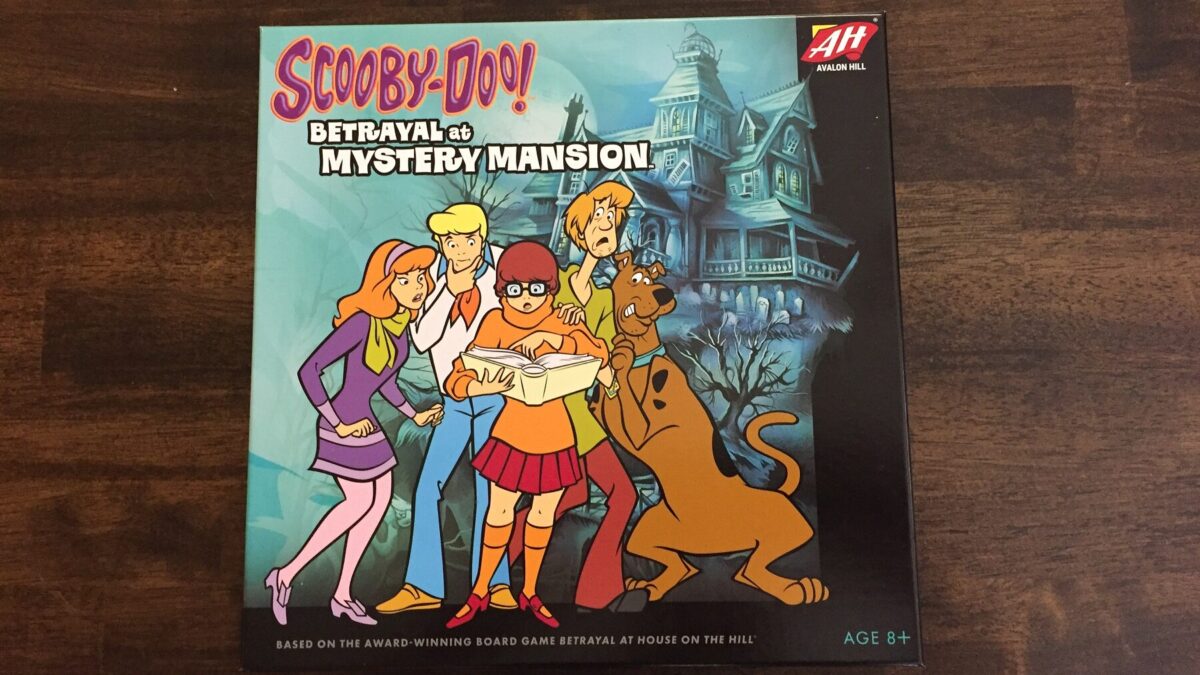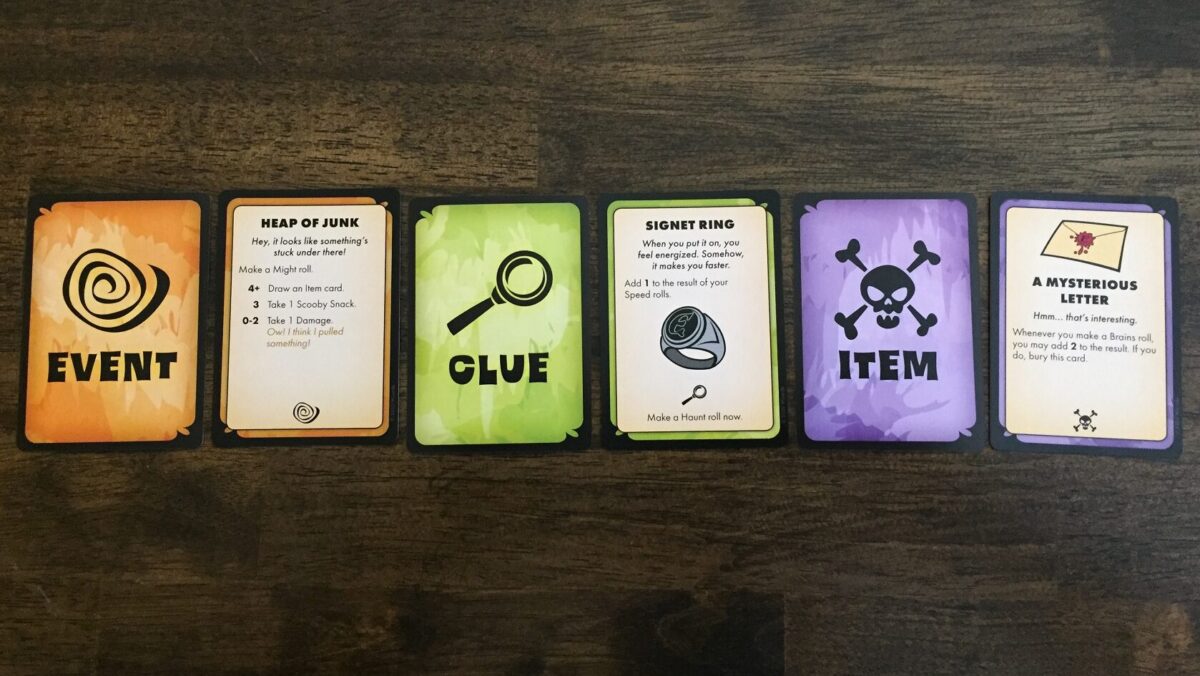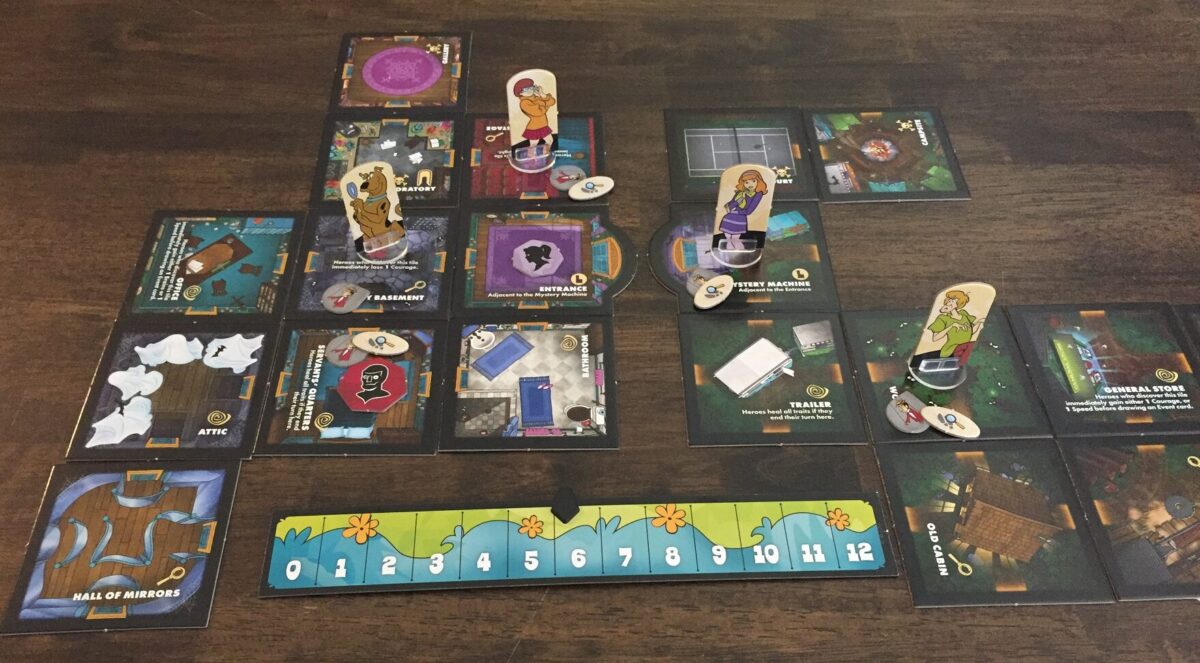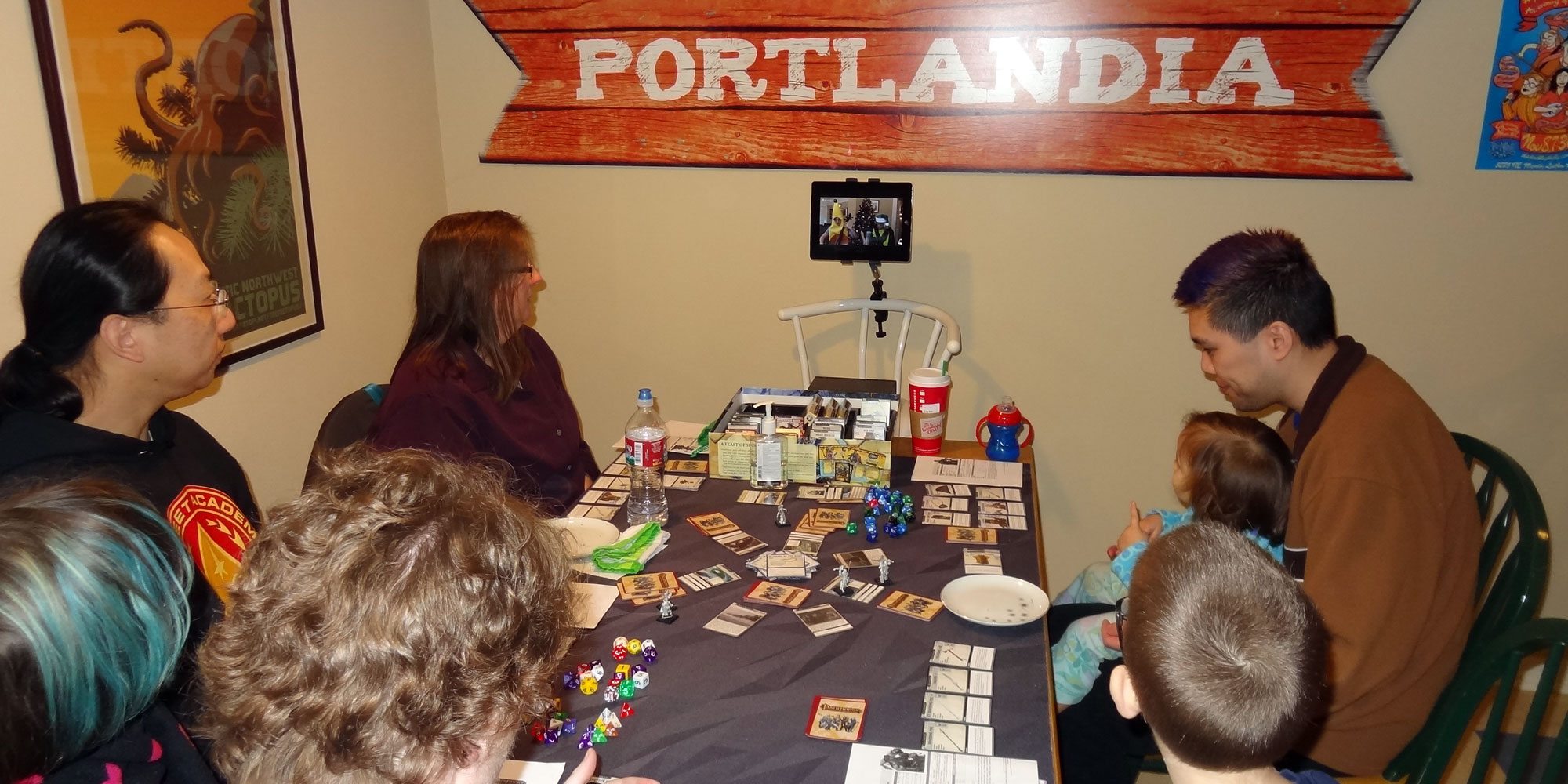
Scooby-Doo and his human companions from the Mystery Inc. Gang are back to solve creepy mysteries. With the recent release of the latest movie, SCOOB!, more children are being exposed to the popular cartoon series which debuted in 1969. (Has it really been that long?) Now you can take on the roles of the popular canine as well as Shaggy, Velma, Daphne, and Fred in order to solve mysteries from the original series in the just-released game, Scooby-Doo: Betrayal at Mystery Mansion.
What Is Scooby-Doo: Betrayal at Mystery Mansion?
Scooby-Doo: Betrayal at Mystery Mansion is a game for 3-5 players, ages 8 and up, and takes about 25-50 minutes to play. The game is based on the popular game Betrayal at House on the Hill and published by Avalon Hill. The game is available from most retailers including Amazon and sells for around $35. Players take on the roles of characters from the series and explore a mansion and the surrounding area. Eventually, they come face to face with the monster and then follow special rules for that specific scenario to defeat the monster or fail in their efforts.
Scooby-Doo: Betrayal at Mystery Mansion Components
Here is what comes in the box.
- 1 rulebook
- 1 Secrets of Survival book
- 1 Monster’s Tome book
- 28 tiles (including 2 starting tiles)
- 5 character cards (Scooby-Doo, Shaggy, Velma, Daphne, Fred)
- 5 character standees (Scooby-Doo, Shaggy, Velma, Daphne, Fred)
- 5 plastic bases
- 1 timer track
- 100 Tokens
- 10 Clue cards
- 14 Item cards
- 25 Event cards
- 8 dice
- 25 plastic clips

In addition to the rulebook, the game also includes two other manuals. They are used once the haunt has been revealed. Then the player who takes on the role of the monster uses the Monster’s Tome while the rest of the players read the Secrets of Survival. These two books provide additional rules and objectives which are unique to each of the 25 different haunts. Don’t read these ahead of time. Instead, wait until the game instructs you which haunt will be played and then turn to those pages at that time.

The tiles are used to create a map as the players explore the mansion and the area outside. Only the two starting tiles are placed initially. Then, as players move around, new tiles for indoor and outdoor locations are drawn from decks of tiles and placed to flesh out the map. Each tile, with the exception of the starting tiles, provides a clue, item, or event when first explored.

As players select a character to play, they each then pick up a character card and matching standee. The cards provide background for the character, list their special ability, and keep track of the status of the four traits: speed, might, brains, and courage. Each character has different initial values for traits as well as a unique special ability. While the cards stay next to the players during the game, the standees are used to show the current location of each character on the map of tiles.

The game includes three decks of cards. Items can be found while exploring and are kept by the player until they are used. Dry ice, a fishing pole, and a Super Shaggy Sandwich are a few of the items available. Events are actions that take place instantly when drawn. They could direct a player to move to another location or require them to make a trait roll with the dice to receive a reward or inflict a penalty. Finally, Clues are like items in that players keep them and can use them. However, they also cause a haunt roll. As more Clues are discovered, the more likely the haunt will be revealed.

Many different tokens are used for the game, though only a few are used each time. Most important are the Scooby Snacks. Players can hold on to these and then spend them to re-roll one die. They can come in handy when fighting against a haunt or trying to complete an objective. Other tokens represent the haunts on the map and other placeholders. Once a haunt begins, the Secrets of Survival manual provides instructions on which tokens are needed and how they are used. The haunts in some games require the time tracker while others do not. Finally, dice are used to make haunt rolls and trait rolls.
How to Play Scooby-Doo: Betrayal at Mystery Mansion
If you have played Betrayal at House on the Hill, then you should be familiar with the basic concepts of Scooby-Doo: Betrayal at Mystery Mansion. However, there are some significant differences and the rulebook contains an entire page listing 11 ways in which this game is different from its predecessor. If you have not played the previous game, not to worry. This game is quick to learn.

Setup
At the start, each player chooses which character they will play as for the game. They collect the corresponding character card and standee and take a Scooby Snack. They also read their character’s special ability and follow it. For example, Fred gets to start off by drawing an item card from the deck while Daphne gets two additional Scooby Snacks. The remaining Scooby Snacks are placed in a token pile. After the haunt begins, other tokens may be added to the pile. The two starting tiles, Entrance and Mystery Machine, are placed in the center of the play area adjacent to one another and the standees are all placed on the Mystery Machine tile. The three decks of cards are shuffled as are the decks of inside and outside tiles. Select one of the five mystery cards, read it aloud, and then set it face-up near the decks of cards. These cards help determine the haunts for the game. One is easy, two are of medium difficulty, and two are more involved. For the first few times playing, use the easy mystery card until everyone learns how to play. Once everything is set up, the youngest player goes first.
Playing the Game
Before getting into gameplay, it is important to understand how the character traits work. The traits range in value from 2 to 8 and some numbers are skipped. Each trait also has a skull icon. If a trait is ever lowered to the skull, the character is stunned. If you are stunned, tip over your standee in its current location. If it is your turn, the turn is over. When you begin a turn while stunned, set the standee upright, and heal all of your traits to their starting values. Then end your turn and continue as normal for the following turn. No one ever dies or leaves the game. When you have to make a trait roll, look at the current value of the required trait and then roll that many dice. Add up the total values of all dice for the result.

When it is your turn, there are several things you can do. You can move a number of tiles equal to your speed. The spaces must be adjacent and connected by a doorway or both tiles must contain a secret passage but don’t need to be adjacent. Characters can also give and take items from other characters who are on the same location tile. For example, Scooby-Doo could take an item from Shaggy, move two spaces, give an item to Velma, and then continue moving. Characters can also discover new tiles. If you are on a tile with an open doorway, not stunned, and still have at least one movement remaining, you can decide to draw a tile from the indoor or outdoor decks, depending on where you are, and then place the new tile so that doorways connect. Once the tile is placed, move the character into the new location and follow any directions on the tile. Draw an Item, Clue, or Event depending on the icon on the tile and do what it states. The player’s turn is then over, even if they have movement remaining.
Players continue exploring the interior of the mansion as well as the area outside. Each time a Clue is drawn, a haunt roll is made. Count the number of Clue cards held by players and roll that number of dice. If the roll is a five or higher, or the 9th Clue has been drawn, the haunt then begins. Stop the play at that point and turn over the mystery card. Find the picture of that last Clue found and then look at the number to the right. This is the haunt that will be played. Normally the player who drew the last Clue takes on the role of the monster. However, the players can decide among themselves who will play as the monster. Younger players or those new to the game may want to be one of the heroes rather than the monster while they learn the game. For the first game or so, you may even want to explore the haunt together.
After the player who will be the monster has been determined, that player takes the Monster Tome and goes into another room to read about the selected haunt. The remaining players are the heroes and read the selected haunt from the Secrets of Survival book. Each book explains how the rest of the game will continue. The monster player removes their standee and places a monster token on their location. Collect the tokens listed in the haunt and place them where instructed. Once everything is set up, the game continues. The haunts can change some of the rules of the game. In addition to giving and taking items, the monster and heroes may be able to attack or perform other actions. Refer to the Secrets of Survival and Monster Tome for the new rules as well as traits for the monster and any of its minions.

The End of the Game
Each haunt has a unique objective. Heroes and the monster each have their own victory conditions. Some haunts have a time limit which uses the timer track. Others play out until either side meets their objective. Once one side has won, the monster refers to the Monster Tome and reads one of two endings depending on who won. The game is then complete.
Why You Should Play Scooby-Doo: Betrayal at Mystery Mansion
I have always enjoyed playing Betrayal at House on the Hill. However, it was a bit too involved and difficult for my children when they were younger. Plus it could be dark at times. Therefore, when I first saw that Avalon Hill was releasing a version of the classic game aimed at younger players, I was excited to try it with my youngest children. Using the Scooby-Doo theme makes Scooby-Doo: Betrayal at Mystery Mansion even more appealing as players take on the role of well-known characters with whom they can instantly identify, especially if they have watched the cartoons and movies. Even the monsters are all taken from the original cartoon series, so it often feels like you are playing through an episode.
While on the topic of characters, the game does a great job of differentiating each of the five choices. Their unique trait values reflect the characters. Scooby-Doo and Shaggy have lower courage, Velma has high brains, Fred has high might and courage, and Daphne has high speed. Even the abilities are customized. Scooby-Doo not only has high speed but can move an extra tile each turn. Shaggy can re-roll two dice for each Scooby Snack he uses. Velma, when making a brains roll, can never roll lower than a 3.
The exploration mechanic fits well with the theme. I enjoy starting with only the Mystery Machine and Entrance tiles and then having to explore to create a map that is different every time. This also serves to help split up the players as some focus on exploring outside while others are inside the mansion. Since every tile lets you draw one of three cards, exploration can help players acquire items that they can use later after the haunt is revealed. Exploration also adds suspense since each new tile added could have a clue which takes the game closer to the haunt.
I like the changes made to the haunt portion of the game. No longer does the player who started the haunt automatically become the monster. The players can choose who will play as the monster and then decide whether to read all the new rules together or divide up into monsters and heroes. In addition, the Monster’s Tome and Secrets of Survival books are well organized and laid out in color-coded sections to make it easy to follow what to do. Shaggy’s section tells the story of the haunt and proves setup instructions. Scooby-Doo lets you know which tokens are needed. Velma has the plan and gives you the objective of the heroes. Daphne explains how to play the haunt. Finally, Fred provides some facts to help with understanding the haunt. The haunts also have modifications depending on how many people are playing. This helps balance the game so the monster is not overwhelmed when playing against four heroes. By dividing the mysteries into beginner, medium, and more involved, the related haunts start out with simpler rules and then become more advanced. This helps players learn the game and allows younger players to more fully participate by choosing a level appropriate for them. Furthermore, unlike the original game, characters never die. Even if a character is stunned, they only lose a turn, but their traits are all stored to their initial values.
Scooby-Doo: Betrayal at Mystery Mansion can play quickly or take a bit longer. The time depends primarily on how long it takes for the haunt to be revealed. My family played a few games where the haunt was revealed after the third clue was found, the earliest possibility, and the clues came up quickly before we had done much exploring. Therefore, once the haunt began, everything was fairly close together. Other games had us nearly exhausting the tiles decks before the haunt started which provided a much larger play area and a longer game. The element of not knowing when the haunt will start really adds to the game, especially as more and more clues are found. If a game ends up being short, just play another. Setup and clean up do not take long. Plus, with 25 different haunts, there is a lot of replayability.
As an adult playing Scooby-Doo: Betrayal at Mystery Mansion, I found the game somewhat simple and a bit easy. However, my younger children really liked it. This game is really designed and geared for children ages 8 to 12 years of age. When playing as a family, younger children could also play with some help from adults or older siblings. My enjoyment came from spending time with my children and playing a game with them. I like the cooperative nature of the game as we decided how we would explore the mansion and outdoor areas, and then once the haunt started, how we would defeat the monster. Since the rules are different for each haunt and require reading, this game is a great way to help children improve their reading comprehension as they must read and then apply what they have read to continue the game. Finally, I am excited to later play the original game with my children when they are a bit older. I definitely recommend Scooby-Doo: Betrayal at Mystery Mansion for families with children in the 8-12 year age range. So get out some Scooby Snacks and solve a bunch of mysteries.
Click here to see all our tabletop game reviews.
![]() To subscribe to GeekDad’s tabletop gaming coverage, please copy this link and add it to your RSS reader.
To subscribe to GeekDad’s tabletop gaming coverage, please copy this link and add it to your RSS reader.
Disclosure: GeekDad received a copy of this game for review purposes.





When we play Betrayal at House on the Hill with out 11 year old,we normally put on the Scooby Doo instrumental background music to help keep the tone light. Plenty of “Hey gang,let’s look for clues”,”jeepers” and “like,no way,man’s abound. I had considered making the Scooby-Doo gang into characters on my own. Now we can go full Scooby!